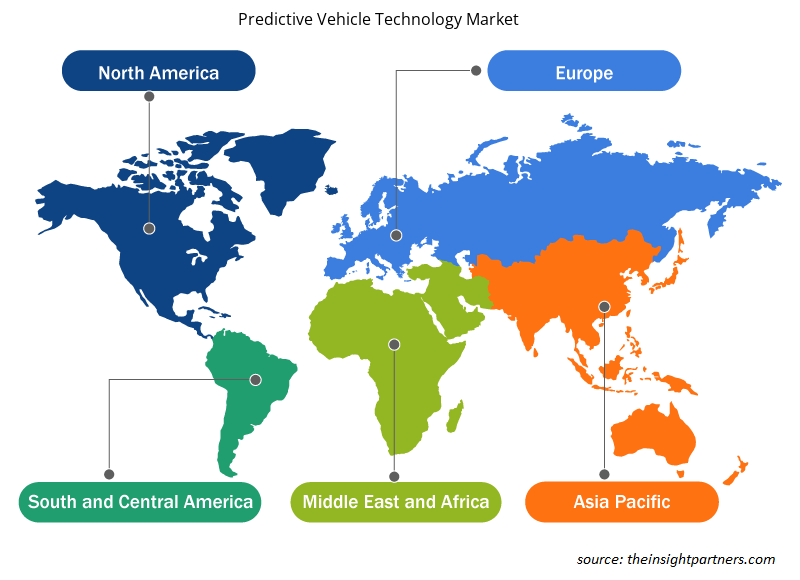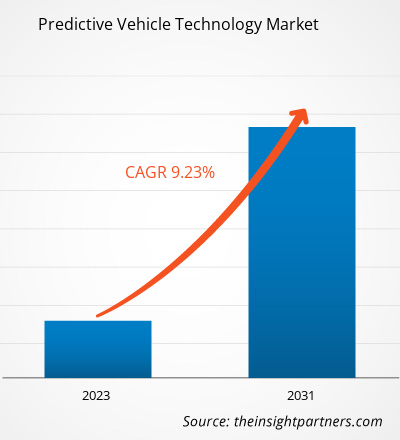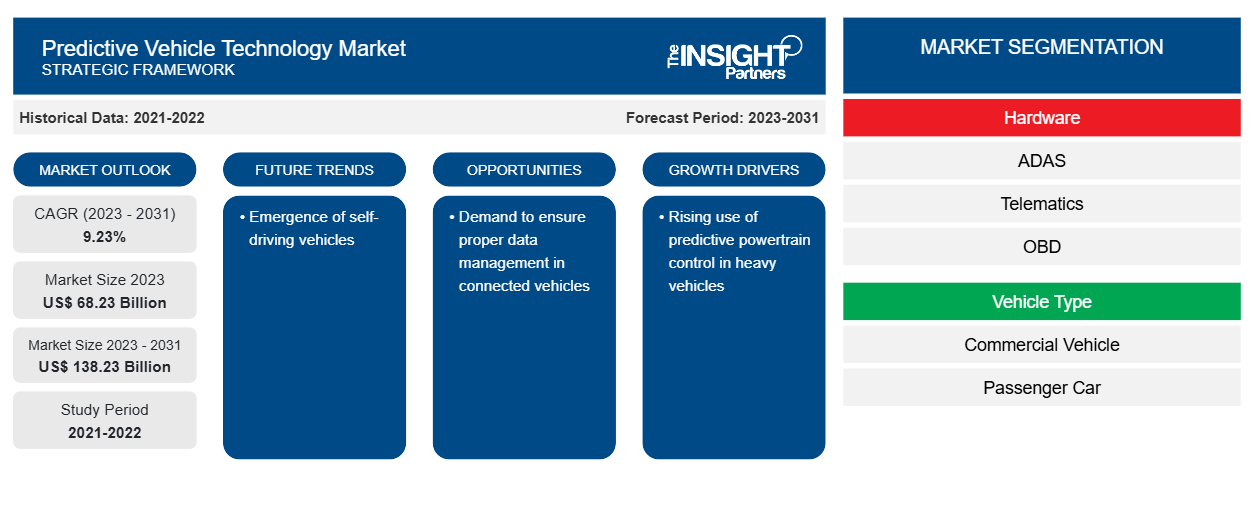예측 차량 기술 시장 규모는 2023년 682억 3,000만 달러에서 2031년까지 1,382억 3,000만 달러로 성장할 것으로 예상됩니다. 이 시장은 2023~2031년에 9.23%의 CAGR을 기록할 것으로 예상됩니다. PPC의 이점은 자동차 제조업체, 특히 대형 상용차 제조업체가 차량에 PPC를 통합하게 만들었습니다. PPC는 거의 모든 유형의 트럭 및 대형 차량에 개조할 수 있습니다.
예측 차량 기술 시장 분석
글로벌 예측 차량 기술 시장 생태계의 주요 이해 관계자로는 기술 공급업체, 구성 요소 공급업체, OEM 및 자동차 산업의 최종 사용자 부문이 있습니다. 기술 공급업체는 자동차 제조업체에 AI, ML 및 예측 기술을 제공하여 이 기술을 ADAS , OBD, 텔레매틱스, V2X 등과 같은 시스템에 통합합니다. 이 언급된 시스템의 구성 요소 제조업체에는 센서, 카메라, 디스플레이 등이 있습니다. 나중에 기술과 통합된 시스템 제품이 차량에 장착되어 운전자와 승객 모두의 안전과 보안을 보장하여 사용자에게 번거로움 없는 경험을 제공합니다. OEM으로 구성된 유통 채널은 최종 사용자 범주에 완제품을 제공합니다. 승용차와 상용차 모두 차량에 예측 기술과 통합된 완제품을 사용합니다. 예측 자동차 기술은 승용차, 밴, SUV 및 트럭을 포함한 모든 유형의 차량에 적용됩니다.
예측 차량 기술 시장 개요
현재 자동차 산업은 탑승자의 안전과 효율성을 개선하기 위해 자동차에 다양한 첨단 기술을 상당히 통합하고 있습니다. 자동차 제조업체는 인공 지능(AI)과 머신 러닝(ML)을 활용하여 운전자의 패턴과 추세를 파악하고 차량의 안전을 개선하고 있습니다. 두 기술 모두 다가올 차량과 자동차 산업의 중요한 부분이 될 준비가 되었습니다. 커넥티드 카와 자율 주행 차량 경쟁에서 예측 차량 기술은 모든 자동차 유형에서 수용되고 있으며, 이는 운전자와 승객에게 상당한 편의성을 제공합니다. 따라서 자동차 제조업체는 음성 명령을 지원하는 차량에 커넥티드 가젯과 IoT를 도입하는 데 주력하고 있습니다. 커넥티드 카에 IoT를 통합하는 것은 자동차 산업에서 지속되는 차세대 디지털 개발입니다. 이 사실은 자율 주행차의 도입을 통해 또 다른 혁명을 가져올 것입니다. 자율 주행차/자율 주행차에는 IoT 차량 간 통신을 가능하게 하고 현실화하는 센서 관리 시스템이 포함됩니다. 앞서 언급한 커넥티드 카의 요소들은 예측 충돌 방지 시스템, 예측 유지 관리 시스템 등을 도입하여 예측 기술 활용을 촉진하는 데 기여할 것으로 예상됩니다.
귀하의 요구 사항에 맞게 이 보고서를 사용자 정의하세요
이 보고서의 일부 또는 국가 수준 분석, Excel 데이터 팩을 포함하여 모든 보고서에 대한 사용자 정의를 무료로 받을 수 있으며 신생 기업 및 대학을 위한 훌륭한 혜택과 할인 혜택을 이용할 수 있습니다.
-
이 보고서의 주요 시장 동향을 알아보세요.이 무료 샘플에는 시장 동향부터 추정 및 예측까지 다양한 데이터 분석이 포함됩니다.
예측 차량 기술 시장 동인 및 기회
대형 차량에서 예측 파워트레인 제어 사용 증가
예측 파워트레인 제어(PPC)는 몇 년 전에 도입되어 현재 시대에 힘을 얻었습니다. PPC를 도입하면 장거리 교통에서 연료 소비를 최대 5%까지 줄이는 데 도움이 됩니다. 이것은 지능형 예측을 통해 금전적 자원을 절약하는 독특한 크루즈 컨트롤 시스템입니다. PPC는 3D 지도와 GPS 데이터를 사용하여 앞의 도로를 스캔합니다. 나중에 시스템은 그에 따라 속도를 자동으로 조정합니다. PPC 개조의 개선은 FleetBoard 텔레매틱스 서비스에 적합합니다. 이는 이미 트럭에 사용되고 있기 때문입니다. 대형 트럭 제조업체는 보완적인 사업부에 접근하여 제품 포트폴리오를 개선하고 PPC 추세에 대한 추가 전문 지식을 습득하고 있습니다. 예를 들어, Mercedes-Benz PPC 기술은 유럽 전역의 Mercedes-Benz 파트너가 Actros, Arcos 및 Antos에서 개조할 수 있습니다. Mercedes-Benz의 PPC는 장거리 주행에서 중장비의 평균 64%를 주문했습니다. 중장비 상용차에 대한 수요가 증가함에 따라 중장비에서 예측 기술 도입이 늘어날 것으로 예상됩니다.
연결된 차량에서 적절한 데이터 관리를 보장해야 한다는 요구
커넥티드 카 분야에서 널리 퍼진 기회는 데이터 관리입니다. 커넥티드 카는 엄청난 양의 데이터를 클라우드로 스트리밍하고 있으므로 엄청난 양의 데이터를 활용하기 위해 예측 분석 및 데이터 분석에 대한 필요성이 커지고 있습니다. 예측 충돌 회피, 예측 유지 관리, 자동차 마케팅, 자동차 마케팅 및 커넥티드 카의 데이터 관리가 시장 성장을 담당하는 성장하는 개념 중 일부입니다. 또 다른 특징은 차량에서 예측 기술 사용을 확대하는 것입니다. 닛산은 빅 데이터, 고급 센서 및 차량 간 연결의 도움으로 예측 충돌 회피 시스템을 개발했습니다. 이 시스템을 사용하면 앞 차량과 앞 두 차량의 거리와 속도를 판단할 수 있습니다. 또한 비정상적인 동작이 있는 경우 운전자에게 비디오와 청각 신호가 전송됩니다. 따라서 예측 충돌 회피 시스템의 엄청난 이점을 통해 자동차 산업은 개발자가 커넥티드 차량 간의 통신을 개선하기 위한 앱을 만들기 위해 앞서 노력하고 있기 때문에 예측 운전자 행동에 기반한 정교하고 효과적인 충돌 회피 시스템을 목격할 수 있습니다.
예측 차량 기술 시장 보고서 세분화 분석
예측적 차량 기술 시장 분석의 도출에 기여한 주요 세그먼트는 하드웨어, 차량 유형 및 애플리케이션입니다.
- 하드웨어를 기준으로 시장은 ADAS, 텔레매틱스, OBD로 구분되었습니다. 골프 카트 부문은 2023년에 더 큰 시장 점유율을 차지했습니다.
- 차량 유형에 따라 예측 차량 기술 시장은 상용차, 승용차로 세분화됩니다. 승용차 부문은 2023년에 시장에서 가장 큰 점유율을 차지했습니다.
- 응용 프로그램을 기준으로 예측 차량 기술 시장은 사전 경고, 안전 및 보안으로 세분화됩니다. 안전 및 보안 부문은 2023년에 시장에서 가장 큰 점유율을 차지했습니다.
지역별 예측 차량 기술 시장 분석
예측 차량 기술 시장 보고서의 지리적 범위는 주로 북미, 유럽, 아시아 태평양, 중동 및 아프리카, 남미의 5개 지역으로 나뉩니다.
미국, 캐나다, 멕시코는 북미의 주요 경제권입니다. 높은 기술 발전으로 인해 북미 지역은 높은 구매력으로 인해 증가하는 인구가 여러 가지 기술 개발을 유치함에 따라 경쟁 시장으로 남아 있었습니다. 수년에 걸쳐 차량은 바퀴 달린 컴퓨터와 더 비슷해졌으며, 이는 현대의 워크숍 기술자가 전문적인 예측 분석 도구로만 작업을 수행할 수 있음을 의미합니다. 예측 유지 관리를 통해 자동차 제조업체는 자동차 부품이 고장나기 전에 수리할 수 있습니다. 예측 유지 관리를 사용하면 제조업체가 제조 공정을 변경하고 향후 제품에 대한 문제를 제거할 수 있습니다. 이 지역은 기술 면에서 매우 발전되어 다양한 회사에서 승용차와 상용차에 예측 유지 관리 도구를 통합하고 있습니다.
예측 차량 기술 시장 지역 통찰력
Insight Partners의 분석가들은 예측 기간 동안 예측 차량 기술 시장에 영향을 미치는 지역적 추세와 요인을 철저히 설명했습니다. 이 섹션에서는 북미, 유럽, 아시아 태평양, 중동 및 아프리카, 남미 및 중미의 예측 차량 기술 시장 세그먼트와 지리에 대해서도 설명합니다.

- 예측 차량 기술 시장을 위한 지역별 데이터 얻기
예측 차량 기술 시장 보고서 범위
| 보고서 속성 | 세부 |
|---|---|
| 2023년 시장 규모 | 682억 3천만 달러 |
| 2031년까지 시장 규모 | 1,382억 3,000만 달러 |
| 글로벌 CAGR (2023-2031) | 9.23% |
| 역사적 데이터 | 2021-2022 |
| 예측 기간 | 2023-2031 |
| 다루는 세그먼트 |
하드웨어로
|
| 포함된 지역 및 국가 |
북아메리카
|
| 시장 선도 기업 및 주요 회사 프로필 |
|
예측 차량 기술 시장 참여자 밀도: 비즈니스 역학에 미치는 영향 이해
예측 차량 기술 시장은 소비자 선호도의 변화, 기술 발전, 제품의 이점에 대한 인식 증가와 같은 요인으로 인해 최종 사용자 수요가 증가함에 따라 빠르게 성장하고 있습니다. 수요가 증가함에 따라 기업은 제품을 확장하고, 소비자의 요구를 충족하기 위해 혁신하고, 새로운 트렌드를 활용하여 시장 성장을 더욱 촉진하고 있습니다.
시장 참여자 밀도는 특정 시장이나 산업 내에서 운영되는 회사나 기업의 분포를 말합니다. 주어진 시장 공간에 얼마나 많은 경쟁자(시장 참여자)가 존재하는지 그 규모나 전체 시장 가치에 비해 나타냅니다.
예측 차량 기술 시장에서 운영되는 주요 회사는 다음과 같습니다.
- 아이신 세이키 주식회사
- 주식회사
- 앱티브 PLC
- 트래필로그 유한회사
- 콘티넨탈 AG
면책 조항 : 위에 나열된 회사는 어떤 특별한 순서에 따라 순위가 매겨지지 않았습니다.

- 예측 차량 기술 시장의 주요 기업 개요를 알아보세요
예측 차량 기술 시장 뉴스 및 최근 개발
예측 차량 기술 시장은 1차 및 2차 조사 이후의 정성적, 정량적 데이터를 수집하여 평가합니다. 여기에는 중요한 기업 간행물, 협회 데이터 및 데이터베이스가 포함됩니다. 다음은 예측 차량 기술 시장과 전략에 대한 시장의 개발 목록입니다.
- 2023년 11월, 뉴올리언스 시는 Connected Operations™ 클라우드의 선구자인 Samsara Inc.의 기술을 사용하여 뉴올리언스 경찰국(NOPD), 뉴올리언스 소방국(NOFD), 공공사업부(DPW), 법규 집행부, 공원 및 공원도로부(PPW), 위생부 등 41개 부서에서 시 차량 운영의 안전성, 효율성 및 지속 가능성을 개선할 것이라고 발표했습니다. 시는 차량에 7,500만 달러를 투자하고 있으며 Samsara와의 기술 파트너십이 차량을 유지 관리하고 보호하는 데 중요하다고 생각합니다. (출처: Samara Inc, 보도자료/회사 웹사이트/뉴스레터)
- 2023년 9월, 선도적인 필수 인프라 서비스 제공업체인 M Group Services의 차량 관리 운영 사업부인 M Group Services Plant & Fleet Solutions(MGSPFS)는 Connected Operations™ Cloud의 선구자인 Samsara와 영국에 본사를 둔 차량 안전 솔루션 제공업체인 Motormax와 협력하여 운전자, 도로 이용자, 시민을 보호하는 차세대 차량 내 안전 시스템을 제공하고 있습니다. (출처: M Group Services Plant & Fleet Solutions, 보도자료/회사 웹사이트/뉴스레터)
적용 범위 및 제공물
"예측 차량 기술 시장 규모 및 예측(2021-2031)" 보고서는 아래 영역을 포괄하는 시장에 대한 자세한 분석을 제공합니다.
- 범위에 포함된 모든 주요 시장 세그먼트에 대한 글로벌, 지역 및 국가 수준의 시장 규모 및 예측
- 동인, 제약 및 주요 기회와 같은 시장 역학
- 주요 미래 트렌드
- 포터의 5가지 힘에 대한 자세한 분석
- 주요 시장 동향, 주요 업체, 규정 및 최근 시장 동향을 포괄하는 글로벌 및 지역 시장 분석
- 시장 집중도, 히트맵 분석, 유명 기업 및 최근 개발 사항을 포함하는 산업 환경 및 경쟁 분석
- SWOT 분석을 통한 자세한 회사 프로필
- 과거 분석(2년), 기준 연도, CAGR을 포함한 예측(7년)
- PEST 및 SWOT 분석
- 시장 규모 가치/거래량 - 글로벌, 지역, 국가
- 산업 및 경쟁 환경
- Excel 데이터세트
최근 보고서
관련 보고서
사용 후기
구매 이유
- 정보에 기반한 의사 결정
- 시장 역학 이해
- 경쟁 분석
- 고객 인사이트
- 시장 예측
- 위험 완화
- 전략 기획
- 투자 타당성 분석
- 신흥 시장 파악
- 마케팅 전략 강화
- 운영 효율성 향상
- 규제 동향에 발맞춰 대응























 무료 샘플 받기 - 예측 차량 기술 시장
무료 샘플 받기 - 예측 차량 기술 시장